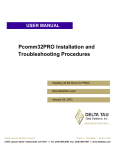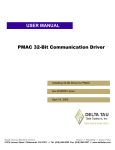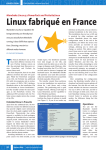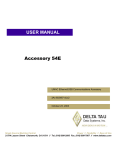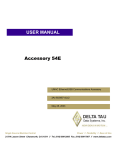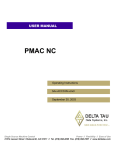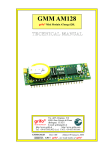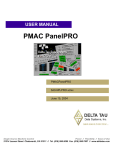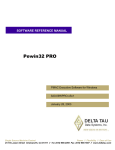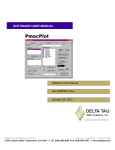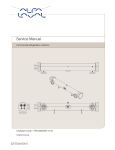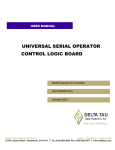Download ^2 Pcomm32PRO Installation and Troubleshooting
Transcript
^1 USER MANUAL ^2 Pcomm32PRO Installation and Troubleshooting Procedures ^3 Installing 32-Bit Driver for PMAC ^4 3A0-09WPRO-xUx0 ^5 August 25, 2004 Single Source Machine Control Power // Flexibility // Ease of Use 21314 Lassen Street Chatsworth, CA 91311 // Tel. (818) 998-2095 Fax. (818) 998-7807 // www.deltatau.com Copyright Information © 2003 Delta Tau Data Systems, Inc. All rights reserved. This document is furnished for the customers of Delta Tau Data Systems, Inc. Other uses are unauthorized without written permission of Delta Tau Data Systems, Inc. Information contained in this manual may be updated from time-to-time due to product improvements, etc., and may not conform in every respect to former issues. To report errors or inconsistencies, call or email: Delta Tau Data Systems, Inc. Technical Support Phone: (818) 717-5656 Fax: (818) 998-7807 Email: [email protected] Website: http://www.deltatau.com Operating Conditions All Delta Tau Data Systems, Inc. motion controller products, accessories, and amplifiers contain static sensitive components that can be damaged by incorrect handling. When installing or handling Delta Tau Data Systems, Inc. products, avoid contact with highly insulated materials. Only qualified personnel should be allowed to handle this equipment. In the case of industrial applications, we expect our products to be protected from hazardous or conductive materials and/or environments that could cause harm to the controller by damaging components or causing electrical shorts. When our products are used in an industrial environment, install them into an industrial electrical cabinet or industrial PC to protect them from excessive or corrosive moisture, abnormal ambient temperatures, and conductive materials. If Delta Tau Data Systems, Inc. products are exposed to hazardous or conductive materials and/or environments, we cannot guarantee their operation. PComm32PRO Installation and Troubleshooting Procedures Table of Contents INTRODUCTION ........................................................................................................................................ 1 A Global View of the Library .................................................................................................................... 1 Supported Operating Systems .................................................................................................................... 2 Hardware Requirements............................................................................................................................. 2 Technical Support ...................................................................................................................................... 2 APPLICATION INSTALLATION AND SETUP ..................................................................................... 3 Software Installation .................................................................................................................................. 3 Automatic Detection of Plug and Play Devices ......................................................................................... 3 Non-Plug and Play [ISA] Devices.............................................................................................................. 5 Windows 98/ME Installation Steps (Non Plug and Play [ISA] Devices)............................................... 5 Windows 2000/XP Installation Steps (Non Plug and Play [ISA] Devices)............................................ 8 Non-Plug and Play [ETHERNET] Devices – Installation for all Supported Operating Systems ........ 12 Installing [Serial] Devices in Windows Operating Systems ................................................................ 14 Installing USB to Serial COM Port [Plug and Play] .......................................................................... 15 Setting up COM Port in Pewin32PRO................................................................................................. 15 FIRST TIME USER (REGISTER THE NEWLY INSTALLED DEVICES)....................................... 17 ISA/USB Modes: DPRAM Configuration ............................................................................................ 18 PCI DPRAM and Interrupt Configuration .......................................................................................... 19 Ethernet Port DPRAM Configuration ................................................................................................. 19 Serial Port Configuration .................................................................................................................... 20 TROUBLESHOOTING THE CONFIGURATION................................................................................ 21 Registry Issues under Windows 2000 and XP ......................................................................................... 21 Part I.................................................................................................................................................... 21 Part II .................................................................................................................................................. 21 Configure/Reconfigure Parameters .......................................................................................................... 22 ISA PMACs: I/O Port Address, DPRAM and Interrupt Assignment.................................................... 22 PCI PMACs: I/O Port Address, DPRAM and Interrupt Assignment ................................................... 24 USB PMACs Configuration ................................................................................................................. 24 Serial Port Communication ................................................................................................................. 25 Higher Baud Rate Considerations ....................................................................................................... 25 USB to Serial Converter ...................................................................................................................... 25 PCMCIA/PCI to Serial Adapters ......................................................................................................... 25 Ethernet Port Communication ............................................................................................................. 25 Ethernet RJ45 Connector .................................................................................................................... 26 Changing Mode of Communication between USB and Ethernet ......................................................... 26 PComm32PRO Benchmark Times........................................................................................................... 27 FIRMWARE DOWNLOADS ................................................................................................................... 29 PMAC/PMAC2 Firmware Downloading Jumpers................................................................................... 29 Firmware Download Supported Modes ................................................................................................... 30 Firmware Download Steps ....................................................................................................................... 30 Table of Contents i PComm32PRO Installation and Troubleshooting Procedures ii Table of Contents PComm32PRO Installation and Troubleshooting Procedures INTRODUCTION The 32-bit PComm32PRO Communication Driver is a set of more than 500 functions written as a development tool for the creation of PMAC 32-bit applications on Windows 98/ME/2000/XP. Nearly all methods of communication to PMAC are included. All types of PMACs (Turbo and non-Turbo) use PComm32PRO for communication to the host computer. The routines were designed with robustness, speed and portability in mind. A Global View of the Library PComm32PRO can be used for Windows 98/ME and Windows 2000/XP application development. The library is structured so that an application using the library created for the Windows 98/ME will also be able to run under Windows 2000/XP as long as the application itself uses no operating system specific functions. PComm32PRO consists of five sets of files. • PComm32.DLL - A 32-bit DLL. • PmacServer.EXE - A Server application, responsible for transferring the Global Data • PmacISA.SYS, PmacPCI.SYS, PmacUSB.SYS - Windows 98/ME/2000/XP kernel drivers. • PmacISA.SYS, PmacPCI.SYS or PmacUSB.INF - Windows Setup Information files. • ETHConfigure.EXE, ETH2Configure.EXE, USBConfigure.EXE, and USB2Configure.EXE (Ethernet and USB configuration applications are responsible for boot firmware download and the IP configuration application is responsible for USB and Ethernet modes of communication.) The illustration below shows how these modules are related. PComm32 Driver Structure Introduction 1 PComm32PRO Installation and Troubleshooting Procedures Supported Operating Systems The following operating systems are supported: • Windows 98 • Windows ME • Windows 2000 • Windows XP Hardware Requirements The PComm32PRO for Windows requires minimum specification of hardware for reliable operation and acceptable performance. These requirements include: • 400 MHz Pentium II and above (of course, a faster computer will yield better throughput.) • At least 20 MB of free disk space and 64 MB of RAM (PRO Suite requires a minimum of 50 MB of free disk space.) • A free serial communications port, USB port, Ethernet port, PCI-BUS slot, or ISA-BUS slot to talk to PMAC for on-line processing • Any monitor with VGA resolution (800x600 with at least 256 colors suggested but 640x480 works fine) Technical Support Delta Tau will respond to any questions or concerns regarding the PComm32PRO or other Delta Tau software packages based on PComm32PRO. For the quickest response, send the inquiry to the following e-mail address: [email protected]. View the website at www.deltatau.com for the latest information and updates. To speak to a technician directly, call Delta Tau Monday through Friday from 9:00 a.m. to 4:30 p.m. PST or fax the request or problem and it will be handled on the next business day. Delta Tau Data Systems, Inc. 21314 Lassen Street Chatsworth CA, 91311 2 Email: Voice: Fax: [email protected] (818) 998-2095 (818) 998-7807 Introduction PComm32PRO Installation and Troubleshooting Procedures APPLICATION INSTALLATION AND SETUP This is a generic procedure for installing and setting up the application and communication drivers for the Delta Tau PMAC. This procedure is applicable regardless of the application being installed (e.g. PRO Suite, PTalkDTPRO, PComm32PRO, etc.). Software Installation 1. Uninstall all old Delta Tau software applications including Pewin32, PmacPlot, NCUI32, PComm32, PtalkDT and the setup programs (P1Setup32, P2Setup32 and TurboSetup32) before beginning the new installation. 2. Install PComm32PRO and/or the application containing PComm32PRO (i.e. PRO Suite, PTalkDTPRO, PmacPanelPRO, etc.). A setup application is provided on a CD-ROM or floppy disk with the Setup.EXE application. Follow the steps provided by the setup application. 3. Restart the computer. Automatic Detection of Plug and Play Devices 1. Perform the steps outlined in the Software Installation section. USB and PCI Plug and Play devices are configured automatically at boot time. In addition, the USB communications port is configured automatically whenever it is plugged in. Note: • • • USB devices are listed in the Universal Serial Bus Controllers class while ISA and PCI devices are listed in the Motion Class in the device manager as shown in the screen below. USB PMAC can be plugged in at any time once the computer has been restarted after the PComm32PRO installation. Serial and Ethernet devices are not listed in any category. No device drivers are required to communicate to PMAC over serial or Ethernet modes. Follow the instructions for the Ethernet configuration as outlined in the Non-Plug and Play (Ethernet) Devices section of this manual. 2. Restart the computer. Application Installation and Setup 3 PComm32PRO Installation and Troubleshooting Procedures 3. The computer will recognize and configure the new hardware. If prompted, give the path of driver files. Depending on the operating systems, these files are in the following folders by default: Windows 98/ME/XP: Windows 2000: c:\windows\system32\drivers c:\winnt\system32\drivers 4. Proceed to the First Time User section of this manual. Notes: 4 a) For Plug and Play devices, the I/O port, DPRAM base address, and Interrupt are assigned by the operating system. There is not an option to change or disable these parameters. However, the parameters assigned by the operating system can be reviewed in the Resources page of the Windows© device manager as shown in the screen below. b) From the latest driver, the interrupts can be enabled or disabled from the properties option of the PmacSelect() function. Proceed to the First Time User section of this manual for details. Application Installation and Setup PComm32PRO Installation and Troubleshooting Procedures Non-Plug and Play [ISA] Devices Non-plug and play (ISA) devices are configured through the standard Windows Add New Hardware wizard. The steps involved in the installation of the PComm32PRO driver under Windows 98/ME and Windows 2000/XP are slightly different. The next three sections describe all the necessary steps involved. Windows 98/ME Installation Steps (Non Plug and Play [ISA] Devices) 1. Perform the three steps outlined under the Software Installation section of this manual. 2. Select the Add New Hardware Wizard from the control panel. 3. Continue through the steps of the Automatic Plug and Play Device Search Wizard. 4. Continue the installation wizard by selecting NO from the Search for New Hardware selection on the following screen: Application Installation and Setup 5 PComm32PRO Installation and Troubleshooting Procedures 5. The first time the software is installed, select Other Devices from the following screen. Once the device database is modified, Motion will be listed in the hardware types list. Select the motion type for future device additions. 6. Once the device database is compiled, Delta Tau Data Systems, Inc. will be added to the manufacturers list. Scroll through the manufacturers list and select Delta Tau Data Systems, Inc. Notes: a) Starting with ProSuite 3.2 (Service Pack 2) and PComm32PRO version 10.47, serial device driver has been eliminated. All PMACs now use Microsoft’s default serial driver. b) This allows the use of most off-the-shelf USB-to-Serial converters. 7. Select PMAC ISA Motion Controller from the Models column as show in the previous screen. Base address, memory configuration and/or IRQ assignments are re-configurable. Serial port configuration such as, port number, baud rate, timeouts, handshake and parity options are completed at the application level. 6 Application Installation and Setup PComm32PRO Installation and Troubleshooting Procedures 8. If asked to specify the path of driver files, browse to find the Windows\System32\Drivers folder. 9. At this stage the driver is installed on the computer. Restart the computer after the driver installation and before further use. The above steps are necessary to add a new device. Assigning resources (base address etc.) is different under Windows 98/ME than Windows 2000/XP. Therefore, the following steps are necessary to assign the appropriate resources to the PMAC ISA configuration. Steps for resource reconfiguration are as follows: There are essentially four configurations available for ISA BUS. They are I/O Port only, I/O Port with DPRAM, I/O Port with DPRAM and IRQ and finally I/O Port with IRQ only. These four configurations are mutually exclusive. Under Windows 98/ME, these resources can be changed only from the System’s device manager. The Device Manager can be launched from the Control Panel’s System Properties menu or directly by clicking the Properties option in My Computer on the Desktop. Application Installation and Setup 7 PComm32PRO Installation and Troubleshooting Procedures 10. From the System Properties screen of the PMAC ISA Motion Controller, select the desired configuration and change the resources according to Jumper settings and available computer resources on the PMAC controller. 11. The following table provides the details for the different configurations: Configuration Number Basic Configuration 0 Basic Configuration 1 Basic Configuration 2 Basic configuration 3 Basic Configuration 4 Basic Configuration 5 Modes of Communication Communication through host port only Communication through host port with DPRAM (regular size) enabled Communication through host port with DPRAM (regular size) and interrupts enabled Communication through host port with Interrupts enabled Communication through host port with DPRAM (large size) enabled Communication through host port with DPRAM (large size) and interrupts enabled A computer restart may be required once the resources have been altered. Once a device is configured successfully, it is registered and available for use. Registering a serial device along with its configuration, such as port number, baud rate, timeouts, handshake and parity options is completed at the application level. Read the First Time User section of this manual for detailed instructions Windows 2000/XP Installation Steps (Non Plug and Play [ISA] Devices) 1. Perform the first three steps outlined in the Software Installation section of this manual. 2. Select the Add/Remove New Hardware option from the control panel. 8 Application Installation and Setup PComm32PRO Installation and Troubleshooting Procedures 3. From the Choose a Hardware Task screen, select Add/Troubleshoot a Device. 4. From the Choose a Hardware Device screen, select Add a New Device. 5. From the Find New Hardware screen, select No to auto-detect options and continue. Application Installation and Setup 9 PComm32PRO Installation and Troubleshooting Procedures 6. From the Hardware Type screen, select Other devices . (This is done for the first installation only.) Once the operating system’s device database is updated, all motion controllers will be listed in the hardware types list. Use this for future PMAC hardware device additions. 7. Once the device database is compiled, Delta Tau Data Systems, Inc. will be added to the manufacturers list. Scroll through the manufacturers list and select Delta Tau Data Systems, Inc. 8. Select the model from the available list (PMAC ISA Motion Controller). Windows 2000/XP allows resource configuration during installation. Therefore, at this stage, base address, DPRAM configuration and/or IRQ assignments can be configured. The following table gives details of all configurations. By default, the basic configuration 0 is selected. Configuration Number Basic Configuration 0 Basic Configuration 1 Basic Configuration 2 Basic configuration 3 Basic Configuration 4 Basic Configuration 5 10 Modes of Communication Communication through host port only Communication through host port with DPRAM (regular size) enabled Communication through host port with DPRAM (regular size) and interrupts enabled Communication through host port with interrupts enabled Communication through host port with DPRAM (large size) enabled Communication through host port with DPRAM (large size) and interrupts enabled Application Installation and Setup PComm32PRO Installation and Troubleshooting Procedures 9. Select the appropriate configuration and after highlighting the resource, click on Change Setting to set the values. 10. Select the driver file PMACISA.SYS. Browse to the correct folder. For Windows 2002, it is located in C:\WINNT\System32\Drivers and for Windows XP, it is located in C:\Windows\System32\Drivers folder. 11. Finish the installation and restart the computer. Review and reconfigure the resources before restarting the computer. Furthermore, these resources can be changed at any time by launching the Device Manager and the Add/Remove Hardware Wizard and clicking Resources. 12. Proceed to the First Time User section of this manual. Application Installation and Setup 11 PComm32PRO Installation and Troubleshooting Procedures Non-Plug and Play [ETHERNET] Devices – Installation for all Supported Operating Systems Configure the Ethernet devices by launching the ETHConfigure.EXE or ETH2Configure.EXE for 10 Base-T and 100 Base-T applications, respectively. Delta Tau provides these files as part of the Pewin32PRO Suite or any other Delta Tau standard installation. Installation and configuration of Ethernet devices is independent of the operating system. The Ethernet mode is supported by a dedicated network only. A network card must be configured on the computer with the PMAC connection before proceeding. Furthermore, a crossover Ethernet cable or a private hub along with two straight cables is required for this setup. 1. Perform the steps outlined in the Software Installation section of this manual. 2. From the control panel, select the properties of the network card that will communicate to the PMAC via the Ethernet. Highlight the Internet Protocol (TCPIP) selection and select Properties. 3. 12 Type the private area IP address (e.g. 192.6.94.2) for this card and enter the subnet mask (255.255.255.0) in the provided spaces. Close the properties page and restart the computer. The Ethernet card configuration on the computer is complete. Application Installation and Setup PComm32PRO Installation and Troubleshooting Procedures 4. To configure the PMAC side, run the EthConfigure.EXE application from programs\ Pewin32PRO\ program group. This application is provided as part of the standard installation and is placed in the c:\Program files\Delta Tau\Common\ folder. Proceed to the main screen by clicking OK. The following message is for future use. The following setup screen will appear: 5. Select the appropriate settings from the following: a. Enter the IP address (e.g. 192.6.94.5) in the Store IP row. Make sure that this address is in the same subnet as the IP address in the PC NIC card. The last entry must be different from the one in the PC (Ethernet Card). b. Select the correct protocol between (UDP and TCP). Only TCP mode is recommended for future Ethernet communication. c. Select the correct hardware type. d. Click the Store IP button. 6. Click Yes to store the IP address in the registry. Close the main screen. The Ethernet PMAC has been added to the device list. 7. For communication boards supporting both USB and Ethernet ports, it is possible to configure one mode (and disable the other mode) by downloading the appropriate firmware in the communication board. A special firmware file and USB cable is required (not provided with standard installation). Contact Technical Support to change the mode of communication. For detailed instructions on how to switch the communication mode between USB and Ethernet on an ACC-54E board or any other PMAC supporting Ethernet and USB mode, read the ACC-54E User manual. Application Installation and Setup 13 PComm32PRO Installation and Troubleshooting Procedures 8. Similar to Ethernet Configuration utility, a USB configuration utility is also provided with any standard installation. The USB configuration utility configures the communication card for USB provided that the correct hardware type and serial number are selected. 9. Proceed to the First Time User section of this manual. Installing [Serial] Devices in Windows Operating Systems Configure the Serial Device to accept a Delta Tau product and identify which COM port each product is connected to (Pmac, Umac etc.). 1. Open the Device Manager in the Control Panel. Go to Ports (COM&LPT) and highlight the port being configured. 2. Right click and select Properties. 3. Click on the Port Settings tab and verify that the settings are as follows: • Bits per Second: 38400 (default) • Data Bit: 8 (default) • Parity: None (default) • Stop bits: 1 (default) • Flow Control: None (default) 14 Application Installation and Setup PComm32PRO Installation and Troubleshooting Procedures Installing USB to Serial COM Port [Plug and Play] After installing the USB to the Serial Device in Windows successfully, the newly added COM Port displays in the Device Manager (e.g., ATEN USB to serial cable [COM3]) with the new COM port number. Setting up COM Port in Pewin32PRO 1. Open Pewin32PRO or similar product and select Setup from the Menu option. 2. Go to General Setup and Options and click the Select button and Insert. All available devices and COM numbers will display. 3. Select the COM port from the PMAC Devices dialog box. Click Test to verify communication with a PMAC device. Application Installation and Setup 15 PComm32PRO Installation and Troubleshooting Procedures 16 Application Installation and Setup PComm32PRO Installation and Troubleshooting Procedures FIRST TIME USER (REGISTER THE NEWLY INSTALLED DEVICES) Once the driver is installed, use the PmacSelect dialog to continue with additional configurations. The PmacSelect dialog is accessible by all programs created with PComm32Pro (via the PmacSelect() function). Launch the supplied Delta Tau application (Pewin32Pro, PMACTestPro, or any application) from the program menu and display the PmacSelect dialog. Product Pewin32Pro Pcomm32Pro PtalkDTPro To Display the PmacSelect Dialog From the main menu item setup, select Setup, General Setup and Options. Select the Default Device tab. Click the Select button. Run the supplied PmacTest application. From the main menu, select Configure\Communications. Also, call the PmacSelect() function from any application that has been coded. Call the SelectDevice() function of PTalk from the supplied or self created programs. 1. From the PMAC Devices screen, select the device number and click Insert. The following window listing all configured devices will appear: 2. Select the device to be configured and click OK. Firmware Downloads 17 PComm32PRO Installation and Troubleshooting Procedures 3. Once a PMAC is listed in the PMAC Select window, it is registered. After a device is registered, it should be tested. At this time, the following screen displays and the device is ready to use in any application. ISA/USB Modes: DPRAM Configuration The DPRAM automatic realtime/background update functions can be enabled or disabled from the properties option of the PMAC Devices menu. The motor mask and global data update rate for both of these automatic functions can be selected. 18 Firmware Downloads PComm32PRO Installation and Troubleshooting Procedures PCI DPRAM and Interrupt Configuration For PCI PMACs along with DPRAM automatic update functions, the additional Enable/Disable Interrupt option is available. Ethernet Port DPRAM Configuration For Ethernet mode of communication, along with DPRAM automatic update functions configuration, the IP address can be viewed. To set the Ethernet mode of communication or change the IP address, use the Ethernet Configuration utility. Firmware Downloads 19 PComm32PRO Installation and Troubleshooting Procedures Serial Port Configuration Select the Properties button in the Serial Devices menu to set the port number, baud rate, timeouts, handshake options and others such as odd/even parity checks. 20 Firmware Downloads PComm32PRO Installation and Troubleshooting Procedures TROUBLESHOOTING THE CONFIGURATION This section covers the issues of communication, Firmware download and others related to changing the card. Registry Issues under Windows 2000 and XP Part I Give the appropriate group or user the right to load and unload device drivers in Windows XP (classic view is required) or Windows 2000. 1. Log on to Windows 2000 with administrator rights. 2. Open the Start Menu, go to the Settings Menu Item, and then open the Control Panel. 3. Next open the Administrative Tools. 4. Next open the Local Security Policy. 5. From the Local Security Settings window, expand the Local Policies Tree. 6. Click the User Rights Assignment folder. 7. In the windowpane on the right side, double click the Load and Unload Device Drivers policy setting. This will open the Local Security Policy Setting window. 8. Click the Add button in the dialog box and add whatever group or user that will have the capability to load and unload the drivers (that is anyone who will run software that communicates to Delta Tau Hardware). Part II Give the appropriate group or user the right to read and write to the HKEY_LOCAL_MACHINE/ System/CurrentControlSet/Services/PMAC key 1. From the Run menu, execute the program REGEDT32.EXE in Windows 2000 or REGEDIT.EXE in Windows XP. 2. From the Windows pull-down menu in the registry editor, select HKEY_LOCAL_MACHINE. (This step applies only to Windows 2000. Skip this step for XP.) 3. Expand the tree in the left panel to HKEY_LOCAL_MACHINE/System/CurrentControlSet/ Services/PMAC. 4. Highlight the PMAC key in the left panel. 5. Click the Security Menu item in the Registry Editor. Then select Permissions from the drop down menu in Windows 2000. In Windows XP, the Permission menu item is in the Edit drop down menu. 6. The Permissions for the PMAC dialog box will occur. From that dialog box, click the Add button and then select the group or user to run Delta Tau Software. Note: Under XP, if the Select Device from Pewin32PRO or the application cannot see a COM port, locate the HKEY_LOCAL_MACHINE/Hardware/DeviceMap/ SerialComm key and give permission to all users to have full control over this key and all entries in it. Firmware Downloads 21 PComm32PRO Installation and Troubleshooting Procedures Configure/Reconfigure Parameters Here are some of the issues that may come out during launching a PMAC application where the applications may fail to establish communication. The following items cover different modes of communication individually. ISA PMACs: I/O Port Address, DPRAM and Interrupt Assignment Full configuration of all ISA PMACs can be viewed and modified from the Device Manager. A yellow or a red sign next to the PMAC ISA controller means that either there is a conflict between the parameters on PMAC and the host computer, or DPRAM is not present while the card has been configured to use DPRAM. The properties page of the PMAC ISA will reveal the details of the parameters. Configure the port address, and add or remove DPRAM and interrupt according to the following table: Configuration Number Basic Configuration 0 Basic Configuration 1 Basic Configuration 2 Basic configuration 3 Basic Configuration 4 Basic Configuration 5 22 Modes of Communication Communication through host port only Communication through host port with DPRAM (regular size) enabled Communication through host port with DPRAM (regular size) and interrupts enabled Communication through host port with Interrupts enabled Communication through host port with DPRAM (large size) enabled Communication through host port with DPRAM (large size) and interrupts enabled Firmware Downloads PComm32PRO Installation and Troubleshooting Procedures All ISA type PMACs are non-Plug and Play and therefore require manual configuration for I/O address, DPRAM and Interrupt assignment. Match the port address to PMAC’s jumper settings (or switch settings for PMAC2), map the DPRAM at an available space in the PC and assign an interrupt card. The following figure gives the details of the parameters of the troubled PMAC ISA device. Available, or more importantly, unavailable parameters are listed in the Device Manager menu of the computer. Important Note: • If an ISA PMAC is configured for DPRAM and after firmware download has been completed, power cycle the PMAC before the DPRAM can be used. • Large DPRAM (64Kbytes) is supported under ISA mode of communication. However, under Microsoft operating systems, it is configured at even addresses only and therefore only two ranges D0000-DFFFF and E0000EFFFF are supported for large DPRAM option. Firmware Downloads 23 PComm32PRO Installation and Troubleshooting Procedures PCI PMACs: I/O Port Address, DPRAM and Interrupt Assignment All PCI PMACs are plug and play and therefore, are configured at boot time. For PCI PMACs, the interrupt is configured automatically. The Delta Tau driver works on the basis of shared interrupts. No steps are required in configuring the interrupts. Similarly, if the option is present, DPRAM is configured and mapped automatically. Bootsprap mode is recognized automatically. The correct sequence for loading the device is to install the driver first and then add the PMAC PCI. On the next boot, the device will be recognized and the driver will be loaded by the operating system automatically. If the PMAC PCI was added and then the software (driver) was installed later, once the driver files are loaded, update the driver manually. The driver can be loaded easily by giving the right path for the Setup Information file (PMACPCI.Inf) and the driver file (PMACPCI.SYS). These files are located in <WINDIR>\Inf and <WINDIR>\System32\Drivers folders respectively. where <WINDIR> = c:\windows for Windows 98/ME/XP <WINDIR> = c:\winnt for Windows 2000 The easiest way to reload a PMAC driver is to install the PC driver first. Then reinstall the hardware and reboot the host computer. USB PMACs Configuration USB PMACs behave similar to the PCI PMACs with one exception: USB PMACs can be plugged in and out at any time. The device will be added to or removed from the device manager automatically. Sometimes it is possible to unplug the USB device even if an application is communicating to it. • 24 For the current hardware, all USB PMACs have DPRAM and the DPRAM is available for automatic DPR functions along with the DPRAM ASCII communication. Firmware Downloads PComm32PRO Installation and Troubleshooting Procedures • • For Turbo PMACs using an USB mode of communication, the DPRAM is mapped at $6C000 instead of $60000 (for ISA and PCI PMACs). I24 determines the address of the DPRAM on a PMAC. It must correspond to the USB address ($6C000) to establish communication. Use the serial communication or some other mode to set I24=$6C000 before using the USB mode of communication. If the UMAC CPU has the onboard DPRAM option present, reinitialize with the E3 jumper and manually change the value of I24 to $6C000. Future generations of USB PMACs will be available in both, with or without, DPRAM option configurations. See the ACC-54E User manual for detailed information. Serial Port Communication Serial communication has its usual issues (baud rate, parity, and handshake signals). This driver requires all of these settings to be correct for successful communication. Baud rate is the most essential of all. • PComm32PRO will not function correctly if the baudrate on the serial port of the host computer is different from the PMAC settings. • Having been able to communicate via Hyper-Terminal is a necessary but not sufficient test in case there is a problem in establishing the communication. • Normal PMAC firmwares, with few exceptions, do not support parity. Furthermore, this driver uses both RTS (enabled) and CTS (checked) handshake signals by default. However, it is possible to change these settings. Once changed, the serial port may require a reset. Reboot the host computer to ensure that the changes have taken effect. Higher Baud Rate Considerations For customers asking for a baud rate higher than 38400, the following table may be helpful: PMAC CPU Speed Supported Baud Rates All PMACs 60 MHz, 90 MHz, 120 MHz, 150 MHz 9600, 19200, 38400 BPS 9600, 19200, 38400, 57600, 115200 BPS Note: Most PMACs support 76800 BPS. However, 76800 BPS is non-standard for most PCs and Microsoft Windows and is not listed in the Com Port settings. USB to Serial Converter Starting with Service Pack 2, most of the USB-to-Serial converters are supported. PComm32PRO now supports the Microsoft serial driver. PCMCIA/PCI to Serial Adapters Similar to an USB-to-Serial converter, PCI-to-Serial converters can be used also, as long as the COM port is created in the Device Manager. Ethernet Port Communication Ethernet communication does not involve any Ring 0 driver. The commands are directed from the DLL directly to the Socket. Therefore, there is no Ethernet PMAC device listed in the Device Manager. Follow the installation steps in the Ethernet Basic Configuration section. The following additional steps can ensure reliable Ethernet communication: 1. Ping the Ethernet card from a command prompt. 2. For maximum speed, only the dedicated mode of communication is recommended. Read the ACC-54E Revision 2 User manual for detailed information on the comparison of the two protocols, their advantages and disadvantages. Firmware Downloads 25 PComm32PRO Installation and Troubleshooting Procedures Ethernet RJ45 Connector This connector is used for Ethernet communications from a UMAC to a PC. The PC must have a card dedicated solely to the UMAC network. The appropriate Category 5 10/100-Base-T network cable that mates to RJ45 can be purchased from any local computer store. The type of network cable to purchase depends on the configuration of the host PC. • When making a direct connection to a Host communication Ethernet card in a PC, a Category 5 networking crossover cable must be used. A standard Category 5 straight through networking cable cannot be used in this scenario. See the left section of the diagram below. • When using a connection to a network Hub or switch, the standard Category 5 straight through networking cable must be used and not a crossover cable. See the right section of the diagram below. Performance can be degraded seriously by the use of a hub or switch. Network hubs or the more intelligent network switches have processors inside them, which can add delays of at least 15 msec to UMAC communications. Changing Mode of Communication between USB and Ethernet UMAC, CPCI and PC104 with both USB and Ethernet options present allow changing the mode of communication between the two. PComm32PRO library and Pewin32PRO Suite come with two utility programs: USBConfigure.EXE and EthConfigure.EXE. To activate these utilities: • Enter the IP configuration, serial number and part identification number. • Download the boot firmware. Procedures involving these updates are: USB Boot Firmware 1. Call Delta Tau Technical Support to get the latest boot firmware file. 2. Connect a USB cable from PMAC’s communication (USB) port to the computer’s USB port. 3. Turn on power to the PMAC board. 4. Launch USBConfigure.EXE from the Programs menu. 5. Click the Store F/W button. 6. Browse to get the path of the PmacUSBxxxFx.iic file. Click OK to start the download. 7. On completion, select the correct hardware type (e.g., ACC-54E, CPCI, QMAC and PC104). 8. Enter the serial number from the communication board in the box provided and click Store ID. 9. Click Done to close the application. 10. Power cycle the PMAC and the communication board to complete the process. 26 Firmware Downloads PComm32PRO Installation and Troubleshooting Procedures Ethernet Boot Firmware 1. Call Delta Tau Technical support to get the latest boot firmware file. 2. Connect a USB cable from PMAC’s communication (USB) port to the computer’s USB port. 3. Turn on power to the PMAC board. 4. Launch ETHConfigure.EXE from the Programs menu. 5. Click the Store F/W button. 6. Browse to get the path of the PmacETHxxxFx.iic file. Click OK to start the download. 7. On completion, select the correct hardware type (e.g., ACC-54E, CPCI, QMAC and PC104). 8. Enter the IP address in the address box and select the mode (either UDP – dedicated network or TCP – on the same subnet). 9. Click Done to close the application. 10. Remove the USB cable and power cycle the PMAC and the communication board to complete the process. PComm32PRO Benchmark Times The following table provides detailed benchmark times for the PComm32PRO driver. Communication Mode GetResponse Upload 8192 I-Variables Download 8192 I-Variables SetMem 8Kbyes GetMem 8Kbytes Firmware Downloads ISA PCI USB Ethernet Serial Turbo PMAC 80 MHz Port DPR ASCII 0.240 0.340 ms ms Turbo PMAC 80 MHz Port DPR ASCII 0.170 0.200 ms ms (2.0) (100 base-T) Port only Port only 38400 BPS Port only 1.8 ms 1.4 ms 450 ms 400 ms 550 ms 640 ms 5 ms (2.30 ms 115 K) 5.4 sec 1.2 sec 1.1 sec 2.4 sec 3.0 sec 30 sec 18 ms 15 ms 11 ms 8 ms 167 ms 125 ms 200 ms 190 ms N/A N/A 27 PComm32PRO Installation and Troubleshooting Procedures 28 Firmware Downloads PComm32PRO Installation and Troubleshooting Procedures FIRMWARE DOWNLOADS This section describes the step-by-step procedure used to update or change the firmware for any PMAC with flash memory (PMAC1, PMAC2, Ultralite, Turbo PMAC1, Turbo PMAC2, Turbo Ultralite, and UMAC). All of the information in this document assumes that the user has a legal copy of the firmware for their PMAC. If the user has any questions about uploading firmware, contact Delta Tau Data Systems, Inc. To change the firmware, place the card into bootstrap mode by powering up the controller with the bootstrap jumper in place. The bootstrap jumpers are listed in the table in this section. Use caution when changing firmware because all information will be erased from the PMAC memory before the firmware is downloaded. Make sure there are complete backup files for the application prior to downloading the new firmware file. Note: If downloading firmware via serial port communications, user must set the baud rate to 38400 regardless of the setting of the baud rate jumpers. PMAC/PMAC2 Firmware Downloading Jumpers Type PC/VME/STD PC/VME/STD PC/VME PC/VME Lite Lite Lite Mini CPU/Memory 3 Battery backed 4 Flash only 5 Universal 6 Turbo 3 Battery backed 4 Flash only 5 Universal 5 Universal Type CPU/Memory PC/VME PC/VME PC/VME Lite Lite Mini VME Ultralite PC Ultralite PC Ultralite UMAC Flash only 5 Universal 6 Turbo 4 Flash only 5 Universal 5 Universal 4 Flash only 5 Universal 6 Turbo 6 Turbo Type CPU/Memory P1 -PC/VME P2 -PC/VME MINI PC Ultralite VME Ultralite 4 4 Flash only 4 Flash only Firmware Downloads PMAC1 Part Number Re-Initialization Bootstrap 602 271/ 272/ 273/ 398-10x** 602 401/ 403/ 405-10x** 602 705-10x** 602866-10x** 602399-10x 602402-100/1/2 602402-103+ 602812-10x E51 E51 <CTRL-R> E51 E51 E51 E51 <CTRL-R> E51 E51 Replace chip E51 <CTRL-O> E4 (CPU) E7 Replace chip E51 <CTRL-O> E106 (2-3) E104 PMAC2 Part Number Re-Initialization Bootstrap 602 401/ 403/ 405-10x** 602 705-10x** 602866-10x** 602406-100 602406-101+ 602405-10x 602643-10x 602415-10x 602182-182 603382-10x E3 <CTRL-R> E3 E3 E3 <CTRL-R> E3 E3 E3 <CTRL-R> E3 E3 E3 E3 <CTRL-O> E4 (CPU) E7 E3 <CTRL-O> E0 (2-3) E0 (2-3) E3 <CTRL-O> E0 E23 E23 Re-Initialization Bootstrap E51 E3 E7 E7 Flex CPU PMAC1/PMAC2 Part Number 603605-10x 603605-10x 29 PComm32PRO Installation and Troubleshooting Procedures 1 Re-Initialization: This copies the factory default values of I-variables, conversion table settings, and VME and DPRAM address settings from the firmware EPROM into active memory. 2 Bootstrap: PMAC enters a special re-initialization mode that permits the downloading of new firmware on flash only CPUs. PMAC can communicate over the PC/STD bus port or over the serial port at a baud rate of 38,400, regardless of the setting of the baud rate jumpers. 3 Battery-Backed CPU: There are EPROMs for the firmware, EEPROM for the basic variables (most Ivariables, conversion table settings, and VME and DPRAM address settings), and battery-backed RAM for the rest of the I-variables, programs, definitions, buffers, and tables. 4 Flash Only CPU: This has segmented flash EEPROM that consists of two sections: one holds the firmware and the second holds all the user settings. To bypass the firmware download procedure, send <CTRL-R>. 5 Universal CPU: This is a CPU that can be built as a battery-backed or flash only CPU. 6 Turbo CPU: This is similar to the flash only CPU. ** CPU piggyback board Firmware Download Supported Modes Starting with PRO Suite 2.0, all modes of communication support firmware downloads provided that a host port communication is available. For UMAC via USB and Ethernet, ACC-54E Revision 102 or above is required. Firmware Download Steps 1. Apply the bootstrap jumper as described in the previous table. 2. From Pewin32PRO menu, go to the Setup menu and select General Setup and Options. 3. Select the appropriate device and then click on the Test button. 30 Firmware Downloads PComm32PRO Installation and Troubleshooting Procedures 4. The controller is now in bootstrap mode. Click the OK button. If Cancel is clicked, the system will issue a CTRL^R and restore normal operation to the PMAC. Important Note: If an ISA PMAC is configured for DPRAM, power cycle the PMAC before the DPRAM is used after firmware download is complete. 5. The program will then ask for a bin file which is actually the firmware binary file. The firmware file (not provided with any installation) is required and can be purchased as an Delta Tau Option (OPT10). For this example, the file is for a UMAC (Turbo PMAC2 type) and is called TURBO2.BIN. Once purchased, store the binary file in any directory. After the file is selected, click the Open button. 6. The program will then ask for initiation of the download. Click the Begin button. Firmware Downloads 31 PComm32PRO Installation and Troubleshooting Procedures 7. When the download file is complete, the following screen displays. There is a 5-second delay before the Done button is available. Click the Done button. 8. The program will then establish communications with the PMAC and the following screen displays. 9. Power down the system and remove the bootstrap jumper. Then restart the controller with the new firmware. 32 Firmware Downloads




































